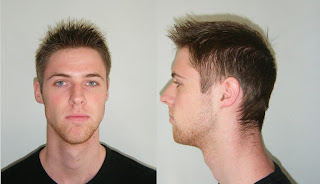Here we go with the first assignment of Year 3. Modelling my own head using 3D Studio Max and a bit of Photoshop. It should be good...
All future blog posts regarding the head model will have been written by me as I work my way through the video tutorials by Eric Maslowski at
http://cg-india.com/tutorials/3dsmax_tutorials_organic_modeling.html.
In order to have a high quality, natural looking end result, we must have well aligned reference plates of the subject. As the subject will be my own head, two photographs were taken. One from the front and one from the side.
 |
| That'll make a good passport photo. |
The image above has had a little work done to it to prepare it for reference. I'll outline these changes below.
Firstly, most cameras will create a bulge effect on the photo. This can be due to the angle the photographer is standing at in relation to the subject. To remove this, we take each image into Photoshop, go to Filter > Distort > Lens Correction. Move the 'Remove Distortion' slider to the right a bit to flatten the image. If you feel the photographer had the camera tilted up or down, the 'Vertical Perspective' slider can help to flatten the image further. To finish with this option box, select the straighten tool and drag a line from one pupil to the other on the face-on image. This will make the image nice and straight.
Next, the profile image needs to be aligned to the face-on one. Pressing ctrl+r in Photoshop will bring up the rulers. Drag some horizontal rulers down to key features on the face such as the pupils, bottom of chin, peak of eyebrows and the centre of the mouth. You can now align the profile image using these. Scale and rotate the profile image as necessary using the free-transform tool on ctrl-t.
The next step is to mark out the contours of the face to make the facial topology clear before modelling. Using a blue brush, I have marked out all of the key features of my face in a way that shows the organic flow. Now, using a red brush, I have marked the topology of my face. This is how I will build the structure in 3DS Max.
I did find the initial marking out of the topology very difficult. I kept getting stuck on how to keep them all quads and to see the flow properly. So I gave up, eventually returned to it the next day with a clear mind and it wasn't very difficult the second time round. For the profile image, only the blue guidelines will be needed.
Now my photos are ready to be made into reference plates. They are acceptable images, but the face-on image is not perfect. You will notice the ear on the left is out further than the right. While humans aren't symmetrical, my ears aren't that lopsided! This was me not facing the camera straight on. I will manage, but I may need to compensate for this on my model later on.














